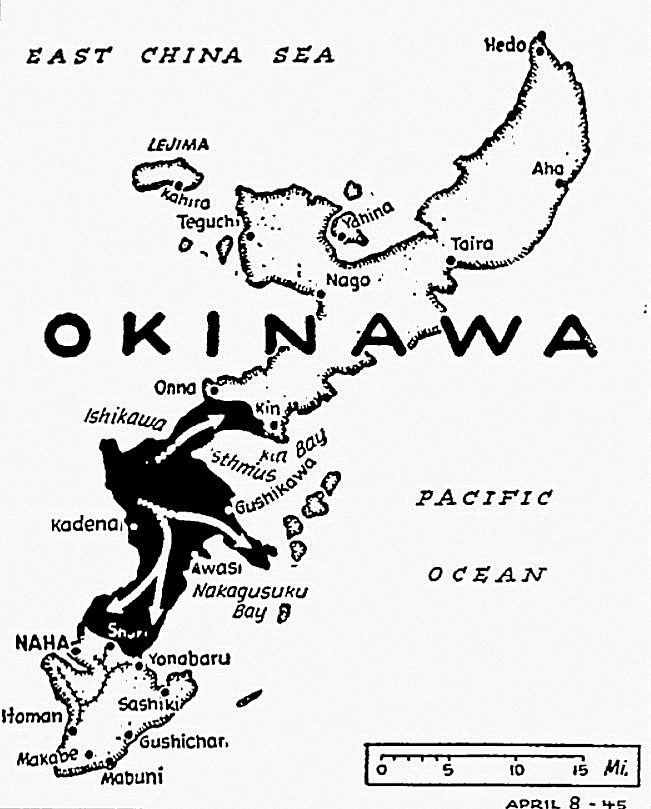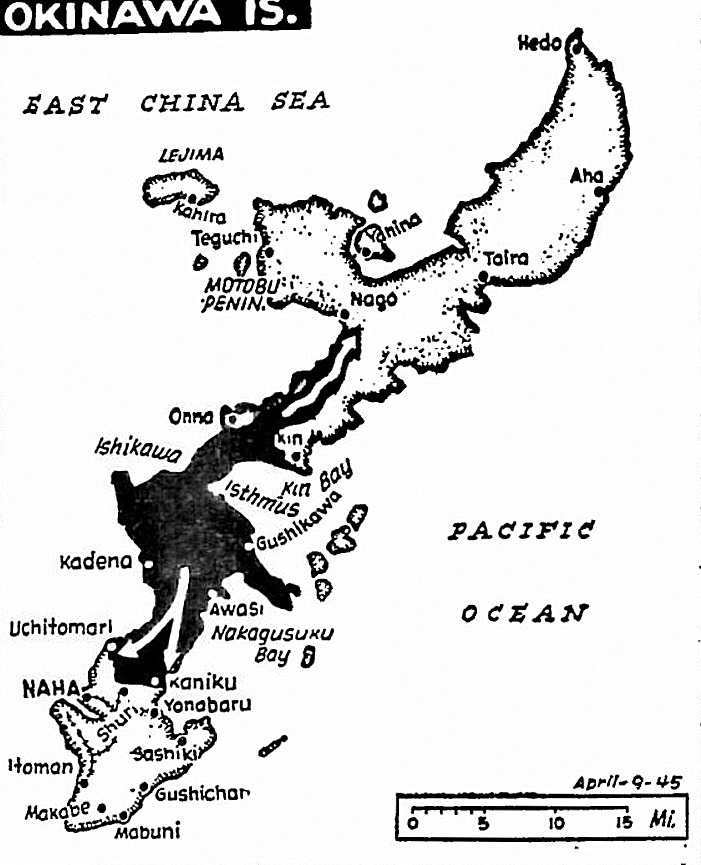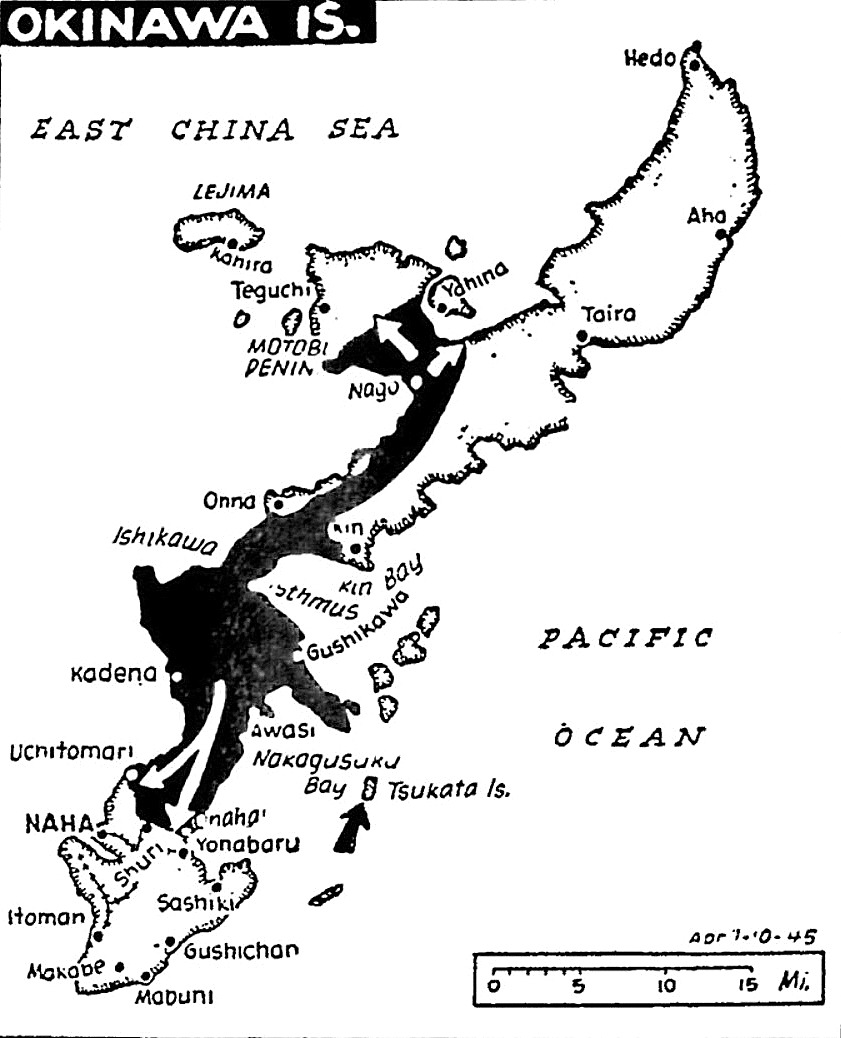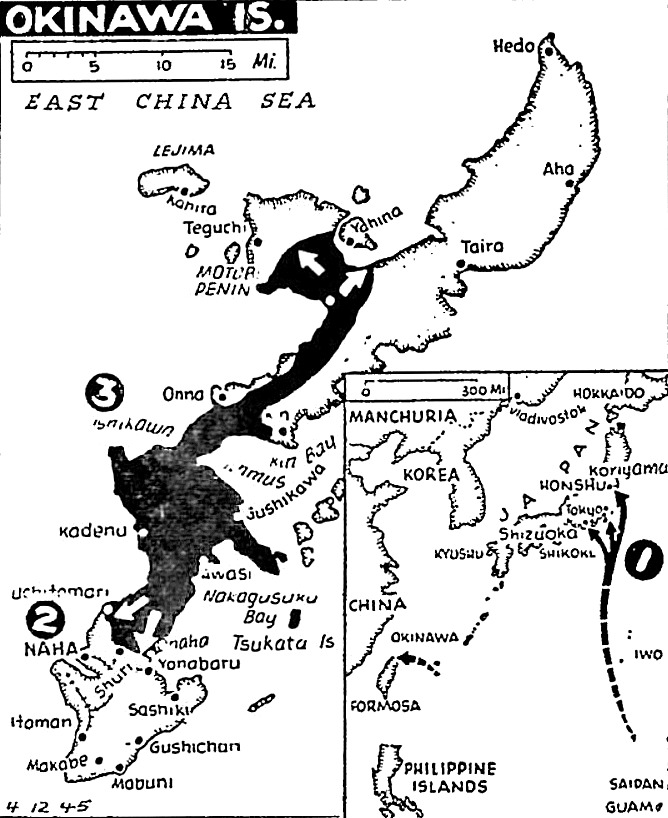The Pittsburgh Press (April 8, 1945)
FOURTH OF JAP FLEET WIPED OUT
Carrier force sinks Tokyo’s largest ship
8 others blasted – 403 planes destroyed
Sunday, April 8, 1945
Steady advances on Okinawa are reported by Adm. Nimitz. Marines gained 3,000 yards on the north of the American front while Army troops advanced on two airports in the south.
GUAM (UP) – U.S. carrier planes wiped out approximately one quarter of Japan’s remaining naval strength Saturday by sinking the 40,000-ton battleship Yamato, the most powerful warship left to the enemy, and destroying or damaging eight other war vessels off the southern tip of Japan.
In addition, the Japs lost 403 planes in two days of frantic and largely unsuccessful attacks on the American invasion forces on Okinawa and in nearby waters.
Adm. Chester W. Nimitz revealed in a communiqué that 12 of a small group of enemy lanes attacking U.S. forces Saturday off Okinawa in a follow-up of Friday’s big assault were shot down to add to the earlier bag of 391 Jap aircraft.
3 U.S. destroyers sunk
The Americans lost seven planes in the attack on the enemy fleet; they lost three destroyers sunk and several other destroyers and smaller craft damaged in the Jap air attacks around Okinawa.
The Japs were trying desperately to interfere with the Okinawa invasion which put U.S. ground troops within less than 400 miles of the Jap mainland. But Adm. Nimitz announced that the American advances on Okinawa continued.
In Washington, a Navy spokesman said that what remains of the Jap fleet is a “not-so-powerful task force which could be easily handled” by any one of the major task forces of the mammoth U.S. Pacific Fleet. He said, “It looks like a good 25 percent of the remaining naval Jap combat force” was wiped out.
Sighted by planes
Adm. Nimitz said the Jap fleet was sighted early today by Navy search planes. It had left the Japanese Inland Sea, where U.S. bombers riddled naval hideouts last month, and headed into the East China Sea, passing south of Kyushu.
Vice Adm. Marc A. Mitscher started a fast carrier task force in that direction. At midday, his planes struck.
About 50 miles southwest of Kyushu, southernmost of the main Jap islands, they sank the Yamato with at least eight torpedoes and eight heavy bombs; a light cruiser of the 6,000-ton Agano class, a smaller cruiser or heavy destroyer, and three destroyers.
Three left burning
Three other destroyers were left burning, and Adm. Nimitz’s communiqué said that only about three destroyers escaped. All enemy ships were strafed heavily with rockets and machine guns.
The naval spokesman in Washington said he believed the number of Jap destroyers in the task force may have been overestimated in the excitement of battle, because the Japs probably didn’t have that many destroyers to spare for screening a task force.
After the terrific losses they had taken over Okinawa, the Japs could muster no planes to protect the task force. They put up a heavy screen of anti-aircraft fire, but to no avail.
The Yamato was Japan’s newest battleship. It was laid down in 1938 or 1939 and was believed to have been commissioned after war began in the Pacific. Although estimated at more than 40,000 tons, its exact size is not known. It had a speed of 30 knots or better.
Task groups participating in the attack on the Jap vessels were commanded by Rear Adm. F. C. Sherman, A. W. Redford, G. F. Bogan and J. J. Clark.
Adm. Nimitz said that on Okinawa, Marines of Maj. Gen. Roy s. Geiger’s III Amphibious Corps advanced steadily in the northern sector of Okinawa up to noon Saturday. At that time, it had driven about 3,000 yards to the vicinity of Nago on the west coast to Orbay on the east.
On the south, infantry of the XXIV Army Corps were meeting heavy gunfire from Jap artillery and mortars, but they made a 2,000-yard advance along the east coast and occupied the town of Tsuwa.
United Press writer James MacLean reported that the Army men were fighting savagely to seize three 1,500-foot-high ridges which bar their way to Naha, Jap naval base town, and to the Machinato and Yonabaru airstrips. The Machinato strip is on the west coast and the Yonabaru on the east.
Fighting was becoming more bloody by the hour. The Japs were battling skillfully from caves, trenches and pillboxes rather than expending troops in suicide charges.
The British carrier task force operating under Adm. Nimitz’s overall command, returned to the Sakishima Islands south of the Ryukyus for a two-day strike against airfields and other installations. British pilots destroyed five Jap planes in the air and three on the ground.
Latest box score of Pacific war
Saturday, April 7, 1945
GUAM (UP) – The following is an official recapitulation of Jap and American warship and plane losses in the major air and sea engagements in the Pacific:
CORAL SEA
| Japan | U.S. | |
|---|---|---|
| Warships sunk | 5 | 3 |
| Warships damaged | 4 | 1 |
| Planes lost | 132 | 66 |
MIDWAY
| Japan | U.S. | |
|---|---|---|
| Warships sunk | 10 | 2 |
| Warships damaged | 7 | No estimate |
| Planes lost | 350 | 150 |
GUADALCANAL
| Japan | U.S. | |
|---|---|---|
| Warships sunk | 18 | 9 |
| Warships damaged | 8 | 10 |
| Planes lost | 70 | 30 |
PHILIPPINE SEA
| Japan | U.S. | |
|---|---|---|
| Warships sunk | 5 | 0 |
| Warships probably sunk | 2 | 0 |
| Warships damaged | 11* | 3 |
| Planes lost | 429 | 100 |
(*superficially)
LEYTE GULF
| Japan | U.S. | |
|---|---|---|
| Warships sunk | 25 | 5 |
| Warships damaged | 33 | Few small craft |
| Planes lost | 423 | No estimate |
OKINAWA
| Japan | U.S. | |
|---|---|---|
| Warships sunk | 6 | 3 |
| Warships damaged | 3 | Several destroyers |
| Planes lost | 391 | 7 |



